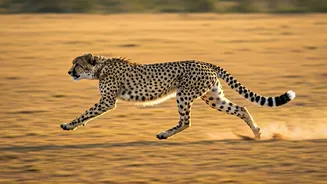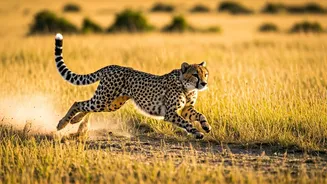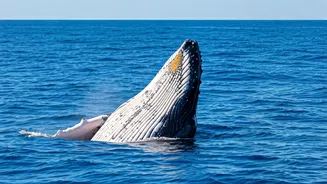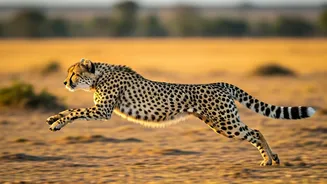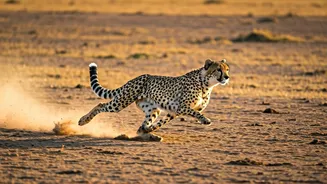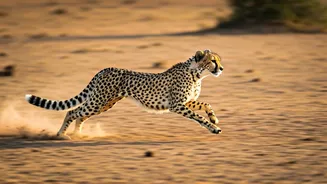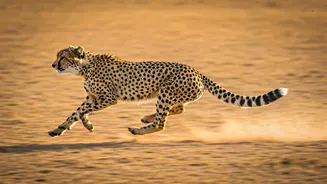Cheetah: The Fastest
The cheetah, renowned for its incredible speed, rightfully claims the title of the fastest land animal. Cheetahs can reach speeds of up to 75 miles per
hour (approximately 120 kilometers per hour) in short bursts, allowing them to chase down prey in the open savannas of Africa. They have a streamlined body, flexible spine, and long legs, all of which contribute to their acceleration and agility. Their semi-retractable claws provide extra grip, and their enlarged nasal passages allow for increased oxygen intake during these high-speed chases. It's truly an amazing creature, adapted perfectly for their hunting lifestyle, demonstrating nature's engineering at its finest when it comes to speed.
Peregrine Falcon: The Diver
The peregrine falcon holds the record as the fastest animal in the world, specifically during its hunting dives. These birds of prey can reach speeds of over 200 miles per hour (over 320 kilometers per hour) when stooping down to catch their prey. Their streamlined shape and specialized feathers allow them to cut through the air with minimal resistance. Their exceptional eyesight enables them to spot prey from great distances, and their powerful talons ensure a secure grip during the high-speed impact. They are truly masters of aerial hunting, showcasing the power of natural selection in designing a creature built for speed and precision.
Sailfish: Aquatic Champion
Sailfish are undisputed champions of the aquatic world when it comes to speed, capable of reaching speeds up to 68 miles per hour (approximately 110 kilometers per hour). These fish have a large dorsal fin, which resembles a sail, and they use it for balance and maneuverability. Their streamlined bodies and powerful muscles allow them to accelerate quickly and navigate the ocean waters with impressive agility. They are opportunistic predators, using their speed to ambush and capture smaller fish. The sailfish's incredible speed is essential for their survival in the dynamic marine environment, allowing them to hunt and evade predators effectively.
Pronghorn: American Speedster
The pronghorn, found in North America, is the second-fastest land mammal, capable of reaching speeds up to 60 miles per hour (approximately 97 kilometers per hour). They possess a combination of adaptations including a large heart and lungs to deliver oxygen efficiently, lightweight bones, and well-developed muscles. Their remarkable vision enables them to spot predators from a considerable distance, giving them a head start in escaping danger. This ability to run fast has been critical for avoiding predators such as wolves and coyotes, particularly when roaming the open plains. The pronghorn's speed is a crucial survival mechanism in its vast habitat.
Black Marlin: Deep-Sea Dart
The black marlin is another incredibly fast fish, known for its powerful swimming capabilities, able to achieve speeds exceeding 50 miles per hour (approximately 80 kilometers per hour). They possess a streamlined body shape and a robust caudal fin, which helps propel them through the water with incredible force. They are apex predators, using their speed to hunt other marine creatures, including tuna and mackerel. The black marlin’s speed and agility make it a formidable predator in its ocean ecosystem, capable of chasing and capturing swift prey in challenging environments.
Frigatebird: Aerial Acrobats
Frigatebirds, often called Man-o'-War birds, are remarkable for their aerial speed and endurance. They are capable of sustained flight at impressive speeds, allowing them to travel vast distances over the oceans. Their long wings and lightweight bodies enable them to glide effortlessly and to efficiently utilize thermal updrafts, reducing the need for constant flapping. They often pirate food from other seabirds and also catch fish near the water's surface. These birds are a perfect example of nature’s ability to optimize creatures for their specific lifestyle, balancing both speed and endurance in their aerial pursuits.
African Wild Dog: Endurance Runner
The African wild dog is known not only for its speed, but also its incredible endurance. They can reach speeds up to 44 miles per hour (approximately 71 kilometers per hour), and are capable of maintaining that speed for extended periods during hunts. They have a lean body, strong legs, and a highly efficient respiratory system, which helps them to run long distances without getting tired. They are cooperative hunters, working as a pack to chase and tire out their prey, often covering great distances during the hunt. This combination of speed and endurance allows them to be successful predators in a variety of African terrains.
